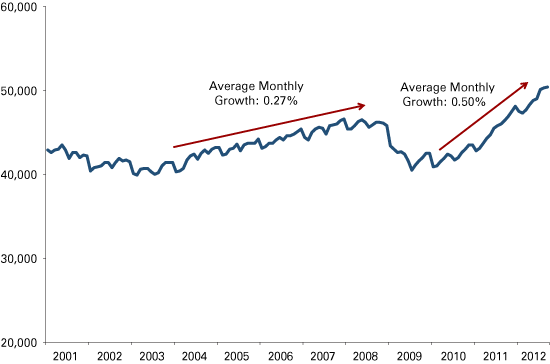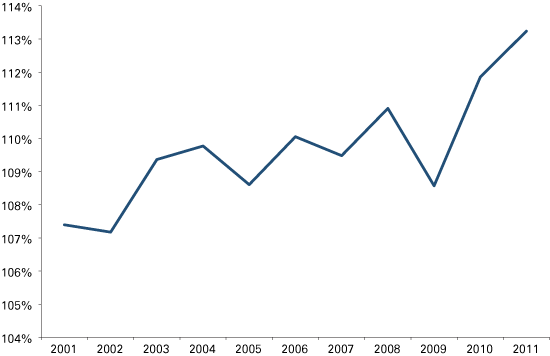Columbus Forecast 2013
MBA Director and Senior Lecturer in Finance, IU Division of Business, Indiana University–Purdue University Columbus
A year ago, 2012 was looking pretty good for Columbus. In fact, that was the official outlook: Within the context of a slower state and national economy overall, the Columbus economy in 2012 would be “pretty good.”
Today, that is a fine description of what happened. Total resident employment in the Columbus MSA (Bartholomew County) is at an all-time high (as of July). You have to go back to the fall of 1999 to find the next closest resident employment numbers.
Total area employment, the number of people working in the Columbus MSA regardless of where they live, is also at an all-time high at 50,400. Since hitting an employment low of 40,500 in July 2009, monthly employment growth has been nearly twice as fast during this recovery as during the previous recovery after the 2001-2002 recession (see Figure 1). Since September 2011, an additional 4,000 people have been put to work—an 8.6 percent increase.
Figure 1: Total Columbus MSA Employment, January 2001 to September 2012

Note: Data are not seasonally adjusted.
Source: Bureau of Labor Statistics
To many of us, area unemployment still seems a little high at 5.4 percent for September. Surprisingly, however, that is lower than the monthly average of 5.8 percent over the past decade. It is also the lowest unemployment rate of any MSA in the state. It is the third-lowest rate at the county level.
Compare this to other manufacturing-heavy areas. Elkhart, Delaware, Howard and Madison counties are still significantly above both the state and national averages. Madison County, home of Anderson, is looking at 9 percent unemployment.
“Pretty good” holds up on wages too. Weekly wages in the Columbus MSA have consistently stayed above the state average. Despite dipping below an annual average of 109 percent of the state’s weekly wages during the slow recovery, it climbed above 113 percent for 2011 (see Figure 2).
Figure 2: Columbus Weekly Wages as Percent of Indiana, 2001 to 2011

Source: Bureau of Labor Statistics
And finally, outside of the numbers, most residents in the area can see for themselves signs of “pretty good.” Retailers are holding up. Construction is up. Home sales and prices are up. It’s not yet a boom by any means, but new home and apartment construction is visible. Downtown Columbus almost bustles.
Outlook
What about 2013? Economic activity in Columbus is always dependent on what happens elsewhere. So all of the economic difficulties and uncertainty confronting others are right here in our view too. There are no more important illustrations of that than the late October release and conference call for Cummins Inc.’s third quarter earnings. CEO Tom Linebarger indicated very clearly that uncertainty is front and center.
Still, the outlook for Columbus in 2013 is yet again pretty good. Here are some reasons.
First, the models out of the Indiana Business Research Center (IBRC) show some relatively good metrics for Columbus. Employment and income are projected to grow faster than the state average again; both look to be among the highest growth rates of all Indiana MSAs.
A second reason for a pretty good 2013 is that the community’s “whole package,” in the spotlight during last year’s outlook, is still attracting employers and talent to Columbus. Not only did the Columbus MSA reach a record high employment in October 2012, but during the past 12 months, year-over-year employment growth was faster in Columbus than all but one other national MSA.
Nearby Honda is increasing output and employment. A local transmission manufacturer plans to double employment over the next few years. Targeting area automotive industry manufacturers, a supply chain services firm will invest $15 million and add at least 50 manufacturing jobs.
Columbus is also home to a booming tourism industry. It accounts for around 8 percent to 10 percent of employment and well over $200 million in annual revenue, growing at almost 6 percent a year. One consequence of this growth is a vibrant downtown residential and commercial district that is absorbing new apartments, parking garages, restaurants and retailers.
Finally, there is also reason to be optimistic about Cummins, the area’s largest employer. Though revenues and profits are down, and though it announced worldwide layoffs of 1,500 (approximately 150 of which will hit local employees), this has all the markings of a company aggressively out in front of concerns about the global slowdown. The company appears to be more proactive than reactive, the latter usually leading to greater negative impact over a longer period of time.
For several years, Columbus has benefited from a local economy diversified by globalism. Ties of many area manufacturers, led by Cummins, to global supply chains and markets mitigated the slow national recovery from the 2007-2009 U.S. recession. This diversification was highlighted in July when it was revealed that over two years, Columbus employers issued immigrant worker visas—largely to managerial and engineering professionals—at a faster rate than any MSA except the San Jose area in northern California.
As global economic growth slowed, particularly in China and Brazil, local manufacturers have seen demand slow. And yet September purchasing and production data offer some evidence that China’s slowdown may have bottomed. To the extent that there is clarity about anything in China, its leadership transition in early November may well lead to more focused attention on continuing its record growth rates.
The point is not so much that 2013 will bring lots of growth. Rather, it’s that 2013 will again, as in 2012, be pretty good locally—pretty good in the context of the much slower growth and general expectations that seem to have become the norm in the U.S.
Also in this Issue…
- International Outlook for 2013
- U.S. Outlook for 2013
- Financial Outlook for 2013
- Indiana's Outlook for 2013
- Indiana's Agricultural Outlook for 2013
- Three Key Indicators—Forecasts for Jobs, Income and Productivity
- Anderson Forecast 2013
- Bloomington Forecast 2013
- Columbus Forecast 2013
- Evansville Forecast 2013
- Fort Wayne Forecast 2013
- Gary Forecast 2013
- Indianapolis-Carmel Forecast 2013
- Lafayette Forecast 2013
- Louisville Forecast 2013
- Muncie Forecast 2013
- Richmond Forecast 2013
- South Bend and Elkhart Area Forecast 2013
- Terre Haute Forecast 2013




